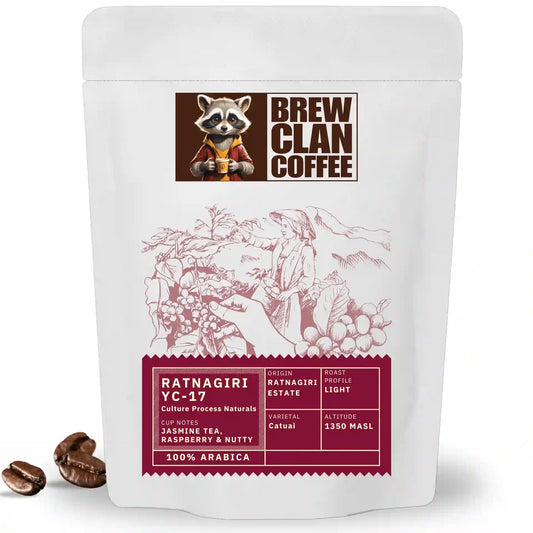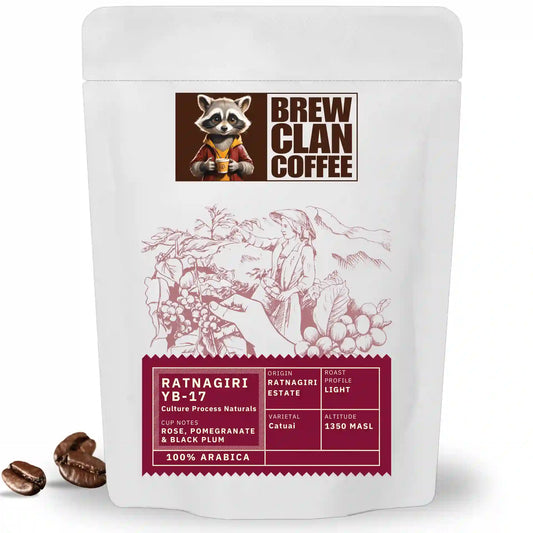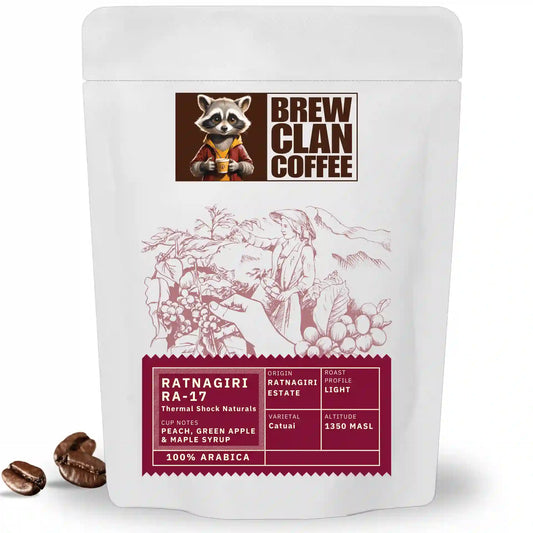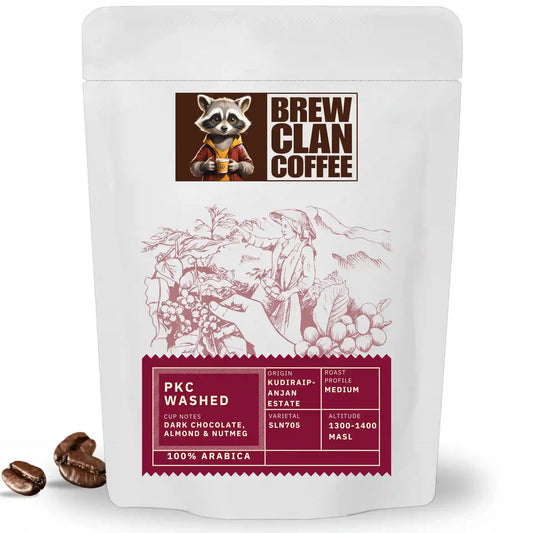
How Does Roast Level Affect Caffeine Content?
Share
Does a dark roast have more caffeine than a light roast? It’s one of the most common questions coffee drinkers ask, and one of the most misunderstood.
Because dark roasts taste bolder and stronger, many assume they must also deliver a bigger caffeine kick.
Meanwhile, some believe lighter roasts are more caffeinated because they’re roasted less.
So, what’s the truth? In this guide, we’ll break down what really happens to caffeine during roasting, why your brew might seem stronger or weaker depending on how you measure your coffee, and what you should actually consider when choosing your roast.
By the end, you’ll know exactly how roast level affects caffeine, and you’ll never have to guess again.
What Happens to Coffee Beans During Roasting
Roasting is what brings coffee beans to life. Green coffee beans are dense, grassy-smelling seeds with little of the flavor we associate with coffee.

When roasted, they undergo dramatic changes:
Moisture Evaporates
Beans lose about 15–20% of their weight as water turns to steam, causing them to dry out.
Beans Expand and Puff Up
The beans nearly double in size, becoming less dense the darker they roast.
Complex Chemical Reactions Develop Flavor
The Maillard reaction and caramelization create the rich aromas and deep flavors we love, transforming the beans from pale green to shades of brown.
Color and Oil Changes
As roasting progresses, beans darken and surface oils can appear in darker roasts.
Despite all these transformations, one thing stays mostly stable: caffeine.
Unlike many aromatic compounds that roast away, caffeine withstands the heat surprisingly well, but how you measure your coffee makes a big difference in how much caffeine ends up in your cup.
Does Roasting Change the Amount of Caffeine?
Many assume roasting burns away caffeine along with moisture and delicate aromas, but the truth is simpler: caffeine is highly stable at the temperatures used in coffee roasting.

Minimal Caffeine Loss
While a tiny amount of caffeine can degrade under extreme heat, it’s negligible in everyday roasting.
Whether a bean is roasted lightly or dark, it retains nearly the same caffeine content by weight.
Roast Level ≠ Caffeine Level
The real changes happen in the bean’s density and flavor, not in its caffeine. So despite what you might hear, light and dark roasts contain almost identical amounts of caffeine gram for gram.
In other words, if you measure your coffee by weight, roast level won’t make much difference to how caffeinated your cup is.
Why Roast Level Seems to Affect Caffeine Per Cup
Even though light and dark roasts have almost the same caffeine per gram, they can deliver very different amounts of caffeine per scoop, and that’s where confusion starts.
Density Differences
- Light roasts are denser because they’ve been roasted for less time. A scoop of light roast contains more mass, and therefore more caffeine, than the same scoop of dark roast.
- Dark roasts are puffier and less dense. A scoop of dark roast has fewer grams of coffee, so less caffeine ends up in your cup if you measure by volume.

Scoop vs. Weight
Measuring by scoop (volume) can cause noticeable caffeine differences depending on roast level.
Measuring by weight (grams) ensures you get consistent caffeine, no matter the roast.
So if you’ve switched roast levels and felt your coffee suddenly seemed stronger or weaker, it may simply be because you measure by scoops, not by weight.
How Flavor and Perceived Strength Confuse the Issue
One of the main reasons myths about caffeine and roast level persist is that our senses can trick us:
Darker Roasts Taste Stronger
Dark roasts have bolder, smokier, more bitter flavors. This intense taste makes many people assume they’re getting more caffeine, even though they might not be.
Lighter Roasts Taste Brighter
Light roasts often taste sweeter, fruitier, or more acidic. They can seem milder, leading some to think they’re weaker in caffeine, when they’re actually just different in flavor profile.
Taste ≠ Caffeine Content
The sensory intensity of a coffee’s flavor doesn’t indicate how much caffeine it contains. Caffeine itself doesn’t taste strong, it’s the roasting process that affects flavor, not caffeine level.
So don’t judge your brew’s kick by how dark or bitter it tastes, measure accurately if you want to control caffeine.
Should You Choose a Roast Based on Caffeine?
The bottom line? Roast level shouldn’t be your main factor if you’re choosing coffee for its caffeine content. Here’s why:
Measure by Weight for Consistency
If you measure your coffee by weight (grams), light, medium, and dark roasts will all give you almost the same caffeine content.
Flavor Matters More
Pick your roast based on the taste you love:
- Light roasts offer bright, complex flavors.
- Medium roasts balance acidity and sweetness.
- Dark roasts bring bold, roasty notes.
Brewing Method Plays a Bigger Role
How you brew, the ratio, grind size, water temperature, and time, affects how much caffeine ends up in your cup far more than roast level alone.
So choose the roast that makes your taste buds happy, and don’t stress about caffeine differences. Enjoying your coffee is what matters most.

Conclusion
Despite what you may have heard, light and dark roasts have nearly the same caffeine content by weight.
The real differences come from density and how you measure your coffee, not how long it’s roasted.
So instead of worrying about caffeine myths, focus on finding a roast level that excites your palate and matches your favorite brew methods.
At BrewClan, we roast specialty-grade coffees across light, medium, and dark profiles, so you can explore what you truly love while enjoying consistent quality and freshness.
Discover your perfect roast today, and brew coffee that tastes amazing, every time.
Explore BrewClan’s Specialty Coffee →
FAQs - Frequently Asked Questions
1. Does dark roast coffee have more caffeine than light roast?
No. By weight, light and dark roasts have nearly the same caffeine. Dark roasts taste stronger, but that doesn’t mean they contain more caffeine.
2. Why do people think dark roast has more caffeine?
Because dark roasts taste bolder and more bitter, people often assume they’re stronger in caffeine, but this is a misconception.
3. Does roasting reduce caffeine in coffee?
Caffeine is stable during roasting, so it doesn’t significantly decrease. Most caffeine remains intact from light to dark roast.
4. How should I measure coffee to get consistent caffeine?
Always measure by weight, not by scoops. Roast level changes bean density, which can affect caffeine per scoop.
5. Which roast should I choose if I want more caffeine?
Since caffeine content is similar across roast levels, pick the roast based on your flavor preference instead of myths about caffeine.
6. Is light roast healthier than dark roast?
Both have similar caffeine and health benefits; the choice comes down to taste. Light roasts offer brighter flavors, while dark roasts bring richer, bolder notes.




